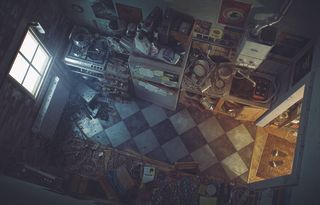
Cornelius is a 3D artist from Germany, who specialises in CG environments using a combination of software and tools.
Cornelius Dämmrich is a 3D artist who talk himself how to create exceptional imagined scenes using Cinema 4D and other 3D modelling and digital art software. He's since worked published award-winning 3D artworks, far-future concepts for NASA’s Jet Propulsion Laboratory, and works for clients like Atlantic Records and BMW.
Born in 1989 in East Berlin, Cornelius currently lives in Cologne, Germany. He made his first digital steps at age six when drawing Michael Denio’s Captain Comic in an early version of PC Paint, and went on to study communication and graphic design.
Below we ask Cornelius about his approach to art, what inspires him and any advice he as for anyone starting a career in 3D art. If you're inspired, then grab one of the best drawing tablets, a laptop for 3D modelling and start creating.

What were your early years creating 3D art like for you?
I liked technology and I was always the creative type, but there wasn’t really any thought of going anywhere with that. Just like playing games, I played with Cinema 4D and Photoshop, and never gave it a second thought. Mainly speaking German at that time and only having poor English skills, I was active in three or four German online forums covering graphic design or ‘GFX’, as it was called back then.
Most of the people my age would build these very technical-looking machines that were made out of hundreds of different layers using Photoshop. We called them ‘interfaces’, and although they looked like skins for the music player Winamp, they never had any functionality. They were just made to look cool.
With time, these interests shifted more to 3D, and I just kept being active in all of these forums. There was a general understanding that something like this was used to make films, but this was still so far away from me and my friends that we never thought of it as something you would pursue as a career. The driving factor behind all of this was curiosity, and the feeling that it felt like magic when something that you’d try actually ended up working.

Over the years, who have been your main sources of inspiration and motivation?
There are many, many things that inspire me. This can be random discoveries on Tumblr blogs or Pinterest, to the artwork of other artists. Right now, my favourite digital artists are Colorsponge, Friendly Robot, Piotr Jabłonski, Marek Denko and a whole lot of others. I think motivation is something you learn with time.
In my growth as a digital artist, I learned that certain things will just take time and projects that would’ve taken me a week to finish 12 years ago will now take at least a month.
When I started getting heavily into CG environments, my main inspiration was the work of Toni Bratincevic and Marek Denko, and I was desperate to find out all their tricks and secrets, only to find out it’s mainly just a lot of work.

Why much of your work centre around the science fiction genre?
When I think of science fiction, I tend to think of Blade Runner or Alien, which are among my favourite films, but my work usually isn’t very much like these films. When I plan a piece, it’s mainly about the atmosphere and the feel. The genre is super irrelevant.
When I want to feel lost in details, anonymous and cosy, like someone who can hibernate and hyperfocus over some technology, something that is science fiction is the first thing that works. Or I can do a grand bazaar with little alcoves and a million layers of fabric, with someone playing around with some kind of astronomy gadget.
But grand bazaars are always warm and less cosy than anonymous mega cities in the rain. The feeling or atmosphere is always the main goal. Science fiction just fits that most of the time.

How do you maintain motivation?
I lose my mind and constantly burn out during my projects. There’s never been a single big project that just works like a charm. There are always episodes full of dread and it can be super boring, hard and demotivating doing them. The thing that keeps me going is the unhealthy perfectionism, imposter syndrome and knowing that things can be better if I do X and Y.
The process is very methodical. I have a sketch or a blockout and chip away at the scene, going from super rough to very detailed. I render a ‘daily’ for every day I’m working on it and make lists of things that feel wrong or unfinished. I use these lists and work them off like a plumber, and when there’s nothing left that bothers me, the piece is finished.
With every project there’s a phase where I feel like a god, when everything works out, things look great and I just fly through the project, super pumped about everything. And then there’s always a phase where I hate myself, my life choices and the field I’m working in. I feel like a fraud, an idiot, and have no motivation to continue, but do it anyway because there’s nothing else I learned.
Sometimes I take a day off, then I’ll just continue to build with tiny steps, and eventually all the tiny steps add up and I end up with a big, beautiful art piece. It’s a fight and a struggle, but it’s also super rewarding, inspiring and can be incredibly fulfilling.

Do you smaller projects help when creating the larger art?
Sometimes I don’t want to spend endless weeks on a single piece. The bigger projects are pieces that cook in my head for years, sometimes some technical aspects make me super anxious and I just continue to plan them out mentally until I feel the time is right.
The longer they cook, the easier it is for me to work on them for longer periods. These smaller pieces are more spontaneous and can be as much fun, and are usually not super stressful to work on. I like to have a mix.

What’s the story behind You Touch, You Buy?
It started with the very plain idea that I wanted to build some sort of corner store in 3D. That was the motivation. While working on it, there was that narrative that evolved from an older piece of mine that’s now connected to the You Touch, You Buy piece.
They share a similar feel and the production of it was also quite similar, because I streamed the whole process on Twitch. I’m quite happy with the result, but there are always things that could be better.


What’s your favourite freelance project ever?
The NASA Comet Hitchhiker. Through a colleague, I got into contact with a researcher at the Jet Propulsion Laboratory (JPL) who was writing a paper on far-future space exploration concepts for the NIAC symposium.
We had a few calls about the general principle, and after some back and forth he pretty much let me do what I wanted, as long as it followed a somewhat realistic guideline.
That pretty much meant I could go hard with NASA spacecraft stuff, got a little bit of money for it, and could in turn tell everyone for the rest of my life that I worked for NASA and the JPL once. 10/10, I would do it again.
What has been your most challenging project to complete?
There are two answers to that. In 2011 I made a piece called Until the Light Takes Us, which was rough because I botched the concepting phase and just started going wild with details before even knowing what it should be.
Back then I always worked pretty brainlessly and just started without giving it any thought, and until that project came my way, that usually worked out fine. But it was a huge struggle mentally as I couldn’t make sense of it, and in the end I threw together some weird narrative about wolves from Norse mythology living in an abandoned space station, so it would ‘mean’ something. It still looks okay, but it was a nightmare.
Without any personal mess-ups, I’d say 2003 was the most challenging. It took me over a year to pull off and it was so incredibly big in just about every regard.
What projects do you have in the pipeline at the moment?
I’m working on some studies about landscapes, trying out new software, and fighting against burnout. Nothing big yet, only smaller stuff. I also want to make a small indie game at some point.

Would you recommend that every artist works like you do?
I don’t think that I have the most elaborate technique and there are probably a million ways to do it better. I would encourage every junior artist to focus on the things they truly enjoy, and strive for greatness when they do so.
Take breaks, breathe in, breathe out, and never forget: it’s a marathon, not a sprint. If you do art as a hobby, just have fun. If you see it as your calling in life, keep in mind that you hopefully get very old and you don’t have to finish one piece every two days. It pays off to take a closer look and think about what you’re building.
Always stay humble, don’t put others down and don’t be unkind. Most importantly, have fun and be curious. That drives everything. I’d never have done my pieces if there wasn’t some initial curiosity. Boredom is the killer of everything.
This content originally appeared in 3D World magazine, the world's leading CG art magazine. Subscribe to 3D World at Magazines Direct.
Get the Creative Bloq Newsletter
Daily design news, reviews, how-tos and more, as picked by the editors.






